|
|
|
Sort Order |
|
|
|
Items / Page
|
|
|
|
|
|
|
| Srl | Item |
| 1 |
ID:
121902
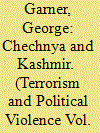

|
|
|
|
|
| Publication |
2013.
|
| Summary/Abstract |
This article examines the transformation of the Chechen conflict from a predominately nationalist to jihadist struggle, and compares the similar changes that took place in the Kashmiri insurgency. Using global jihadist strategy and ideology, and the accompanying influence of Al Qaida, both conflicts are shown to have taken on a new ideology and to have expanded beyond previous areas of operation. In both instances, the political leadership wrapped themselves in the mantle of political Islam (Islamism) as ensuing violence led to rapid socioeconomic transformation and social breakdown, thus allowing foreign jihadists to exert power and take up/divert the cause. In the past few years, two main groups originating in Chechnya and Kashmir have taken on Western targets and become more indoctrinated in Al Qaida's global jihadist ideology: the Caucasus Emirate (CE) and Lashkar-e-Taiba (LeT). The opportunist franchising strategy of Al Qaida could come to play a role in the future of both groups, especially if the CE is able to coalesce into a more unified front. More importantly, the global jihadist attributes of the CE must begin to garner the same attention in the Western world as that of LeT.
|
|
|
|
|
|
|
|
|
|
|
|
|
|
|
|
| 2 |
ID:
121904


|
|
|
|
|
| Publication |
2013.
|
| Summary/Abstract |
Chinese arms sales to Africa have increased in recent years. In a region beset by conflict and unstable regimes, and where arms sales are a significant and positive predictor of an increased probability of political violence, this is inherently problematic. The sale of weaponry to a regime in Khartoum caught up in an alleged "genocide" in Darfur, the awkward appearance in 2008 of a Chinese ship loaded with weapons bound for Mugabe's Zimbabwe off the coast of eastern Africa, and the recent exposure in 2011 that Chinese arms companies offered to sell around $200 million worth of arms to Muammar Gaddafi's regime are emblematic of an issue in Africa's political violence that needs analysis. This article seeks to discuss the rationale behind China's arms sales to Africa and the effect that they have had on political violence in recipient countries. It also provides an analysis of the supply-and-demand circumstances of Chinese arms transfers to Africa, Beijing's attempts to control such transfers, and evidence that Chinese policies on proliferation are (slowly) evolving.
|
|
|
|
|
|
|
|
|
|
|
|
|
|
|
|
| 3 |
ID:
121901
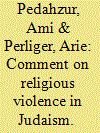

|
|
|
|
|
| Publication |
2013.
|
| Summary/Abstract |
Gideon Aran and Ron Hassner, both distinguished scholars of religious violence, offer a rich discussion of violence in Judaism. They guide the reader on a tour from the past to the present, making stops at crucial crossroads and offering a sophisticated discussion in which they draw lines between biblical texts, culture, and contemporary political events. The authors' backgrounds (Aran is an anthropologist and Hassner is a political scientist) turn the text into a compelling exploration of the phenomenon and a real tour de force.
|
|
|
|
|
|
|
|
|
|
|
|
|
|
|
|
| 4 |
ID:
121905
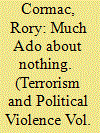

|
|
|
|
|
| Publication |
2013.
|
| Summary/Abstract |
Through its ability to transcend not only national boundaries but so too departmental jurisdictions and the traditional public-private security divide, the rise of international terrorism in the late 1960s and early 1970s posed a number of challenges to the British intelligence machinery which remain relevant today. This article focuses on the dangers and mechanics of threat exaggeration and the importance of intelligence coordination to ensure that threats are assessed and reports are disseminated in a realistic manner. Using the over-emphasised threat of maritime terrorism in 1970 as a case study, this article is able to examine the intelligence cycle as a whole and consider the importance of source validation, the dangers of incremental analysis, and the need for coordinated advice disseminated coherently to consumers both inside and outside of the government.
|
|
|
|
|
|
|
|
|
|
|
|
|
|
|
|
| 5 |
ID:
121900
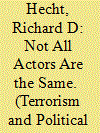

|
|
|
|
|
| Publication |
2013.
|
| Summary/Abstract |
Gideon Aran and Ron Hassner begin their article on "Religious Violence in Judaism: Past and Present" by noting different scholarly ways to think about the relationships between religion and violence. First, there are those who believe that religion is inherently violent and thereby trivialize history and reduce the agency of actors belonging to religion. Second, there are those who argue certain religions have a violent core and other religious traditions are inherently peaceful. They too strip the actors within these traditions of responsibility or agency. They are violent or peaceful because that is the nature of their religious traditions. Third, there are those who argue in a classic instrumentalist view in which religion is a very effective system to either mobilize people to act violently or to justify the violence.
|
|
|
|
|
|
|
|
|
|
|
|
|
|
|
|
| 6 |
ID:
121898
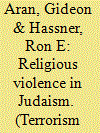

|
|
|
|
|
| Publication |
2013.
|
| Summary/Abstract |
Throughout Jewish history, religious tradition has had a dialectical relationship with violence. Judaism is neither more nor less violent than any other religion. In this essay, however, we offer a comprehensive and integrated survey of the components of Jewish ethos and mythos relating to violence while analyzing and illustrating their development and influence over the course of three millennia, from biblical times to the contemporary Jewish world, particularly in the Jewish State. We analyze the various transformations that Jewish religious violent norms, values, moods, and symbols have undergone, their linkage to ever-changing social and cultural circumstances, their social-political roots and implications, and their relationship to other Jewish traditions. We trace how ancient violent motifs have emerged and have been processed over time, and observe present-day violent behavior in light of these motifs. Along the way, we explicate the dynamics that characterize the tradition of Jewish religious violence and its paradoxical nature. Our argument implies a general theoretical model of religious violence that can be applied in a comparative context: Actors engage in a constant evaluation, selection, and reinterpretation of religious ideas and practices from an ever-growing reservoir and in so doing contribute to that reservoir. Religious tradition is adaptable but it also places limits on the violence agents can justify at any point in time.
|
|
|
|
|
|
|
|
|
|
|
|
|
|
|
|
| 7 |
ID:
121899
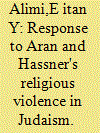

|
|
|
|
|
| Publication |
2013.
|
| Summary/Abstract |
The editors of Terrorism and Political Violence have been right to place Aran and Hassner's "Religious Violence in Judaism: Past and Present" at the center of this issue, and to solicit a scholarly debate around this important piece. As a political sociologist who is not indifferent to either Jewish religious violence in particular or the study of political violence and terrorism in general, I can easily think of several reasons. The first reason is that Aran and Hassner's explanatory framework is dynamic and context-sensitive; the second concerns the impressive balance between and attentiveness to violent and nonviolent elements in religion; and, the third reason relates to the timeliness of the topic of Jewish religious violence. In what follows, I critically evaluate the first two reasons, and in concluding refer to the third one. It should be pointed out that the underlying motif that "connects the dots" of my response relates to the relative neglect of "relational aspects" in Aran and Hassner's framework, and on which I say more below.
|
|
|
|
|
|
|
|
|
|
|
|
|
|
|
|
| 8 |
ID:
121897
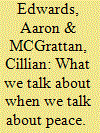

|
|
|
|
|
| Publication |
2013.
|
| Summary/Abstract |
Kieran McEvoy and Peter Shirlow's response to our article is emblematic of the very tendencies towards the creation of problematic conceptualisations of peace that we had set out to critique. 1 Our article sought to problematise the over-confidence of claims that everything was "settled" and that we must thank terrorists and ex-terrorists for their magnanimous gift of having led us out of the very situation they led us into in the first place, as if peace was a privilege and not a right. We characterised the tendency to overinflate the role of paramilitaries in fostering peace as equivalent to the promotion of what we termed "terroristic narratives"-namely, stories that elided notions of "peace" with terrorists' own self-justifications. We suggested that the political effect of this was to defer recognition of the nationalising impulse behind terrorist campaigns in Northern Ireland-an impulse that remains in the post-hoc appraisals by terrorists of their actions. We suggested that the failure to tackle this could be deleterious for the stated objectives of both the British and Irish governments to cultivate a shared society in Northern Ireland.
|
|
|
|
|
|
|
|
|
|
|
|
|
|
|
|
| 9 |
ID:
121903
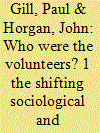

|
|
|
|
|
| Publication |
2013.
|
| Summary/Abstract |
This article presents an empirical analysis of a unique dataset of 1240 former members of the Provisional Irish Republican Army (PIRA). We highlight the shifting sociological and operational profile of PIRA's cadre, and highlight these dynamics in conjunction with primary PIRA documents and secondary interview sources. The effect of these changes in terms of the scale and intensity of PIRA violence is also considered. Although this is primarily a study of a disbanded violent organization, it contains broad policy implications beyond the contemporary violence of dissident movements in both Northern Ireland and the Republic of Ireland. We conclude with a consideration of how a shifting sociological profile impacts upon group effectiveness, resilience, homogeneity, and the turn toward peaceful means of contention.
|
|
|
|
|
|
|
|
|
|
|
|
|
|
|
|
|
|
|
|
|